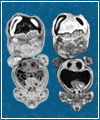|
|
|
|
|
|
|
|
 |
Specimen Selection and Preparation Whole human embryo specimens from Carnegie stages 13 to 23 were selected from the Carnegie Collection of Human Embryos at the National Museum of Health and Medicine, in the Armed Forces Institute of Pathology (AFIP). These stages approximately represent 32 to 56 days post-ovulation. Formalin-fixed specimens without signs of mechanical damage and without obvious signs of malformations were selected whenever possible. In some cases, embryos with suspected malformations were imaged because more suitable specimens were not available to represent those stages of development. All embryos were photographed with a digital camera on an optical microscope prior to magnetic resonance microscopy (MRM) . The larger and well-fixed embryos (over stage 17) were immersed in Fomblin LC08 (Ausimont USA, Inc., Thorofare, NJ) during MRM imaging to provide a background without signal. Smaller and poorly-fixed specimens were imaged in formalin because they would not have tolerated the density of the Fomblin medium. However, formalin does not provide as much contrast between the embryo and the background medium as the Fomblin does. All embryos were placed in airtight plastic containers and inserted into an imaging coil. Four MR imaging coils were built to accommodate the 10-fold size differences of these embryos: a Helm-Holz coil for the smallest embryos, a solenoid coil for the next sizes, and then two bird-cage coils for the larger specimens. MRM Imaging
The embryos were separated from background noise in the sagittal images using thresholding and seeding (the "wand" tool) and masking tools in Adobe Photoshop. These same tools were used to produce the segmented data sets containing single organ systems. The segmented (organ) data sets maintain the original slice numbering system and therefor do not always begin with slice #1 if the organ was not found in slice #1. Coronal and axial images were obtained from the cleaned sagittal images using VoxelView_Ultra 2.5 software (Vital Images, Fairfield, IA) running on a Silicon Graphics workstation. QuickTime animations were created using volume rendering in VoxelView_Ultra, and psuedo-timelapse animations were created using the Gryphon Morph 2.5 software.
|
|
| Carnegie Stage | Post Ov. Days (approx.) | Scan # | TR | TE | Flip Angle | Scan Type | Coil | Resolution* | NEX |
| 13 | 28 | 11634 | 95 | 3.5 | 60 | T1 | HelmHolz | 39.1 | 2 |
| 11635 | 1000 | 15 | 90 | Diffusion | HelmHolz | 39.1 | 1 | ||
| 11636 | 1000 | 50 | 90 | T2 | HelmHolz | 39.1 | 1 | ||
| 14 | 32 | 11627 | 95 | 3.5 | 60 | T1 | HelmHolz | 39.1 | 2 |
| 11628 | 1000 | 15 | 90 | Diffusion | HelmHolz | 39.1 | 1 | ||
| 11629 | 1000 | 50 | 90 | T2 | HelmHolz | 39.1 | 1 | ||
| 15 | 33 | 11537 | 95 | 3.5 | 60 | T1 | Solenoid | 54.7 | 2 |
| 11538 | 1000 | 15 | 90 | Diffusion | Solenoid | 54.7 | 1 | ||
| 11539 | 1000 | 50 | 90 | T2 | Solenoid | 54.7 | 1 | ||
| 16 | 37 | 11894 | 95 | 3.5 | 60 | T1 | Solenoid | 62.5 | 2 |
| 11897 | 1000 | 15 | 90 | Diffusion | Solenoid | 62.5 | 1 | ||
| 11898 | 1000 | 50 | 90 | T2 | Solenoid | 62.5 | 1 | ||
| 17 | 41 | 11422 | 95 | 3.5 | 60 | T1 | Solenoid | 46.9 | 2 |
| 11424 | 1000 | 15 | 90 | Diffusion | Solenoid | 46.9 | 1 | ||
| 11423 | 1000 | 50 | 90 | T2 | Solenoid | 46.9 | 1 | ||
| 18 | 44 | 11430 | 95 | 3.5 | 60 | T1 | Bird Cage | 78.1 | 2 |
| 11431 | 1000 | 15 | 90 | Diffusion | Bird Cage | 78.1 | 1 | ||
| 11432 | 1000 | 50 | 90 | T2 | Bird Cage | 78.1 | 1 | ||
| 19 | 47 | 11239 | 95 | 3.5 | 60 | T1 | Bird Cage | 70.3 | 2 |
| 11237 | 1000 | 15 | 90 | Diffusion | Bird Cage | 70.3 | 1 | ||
| 11238 | 1000 | 50 | 90 | T2 | Bird Cage | 70.3 | 1 | ||
| 20 | 50 | 11906 | 95 | 3.5 | 60 | T1 | Bird Cage | 101.6 | 2 |
| 11907 | 1000 | 15 | 90 | Diffusion | Bird Cage | 101.6 | 1 | ||
| 11908 | 1000 | 50 | 90 | T2 | Bird Cage | 101.6 | 1 | ||
| 21 | 52 | Not Available | |||||||
| 22 | 54 | 11525 | 95 | 3.5 | 60 | T1 | Bird Cage | 140.6 | 2 |
| 11526 | 1000 | 15 | 90 | Diffusion | Bird Cage | 140.6 | 1 | ||
| 11527 | 1000 | 50 | 90 | T2 | Bird Cage | 140.6 | 1 | ||
| 23 | 56 | 11616 | 95 | 3.5 | 60 | T1 | Bird Cage | 156.3 | 2 |
| 11617 | 1000 | 15 | 90 | Diffusion | Bird Cage | 156.3 | 1 | ||
| 11618 | 1000 | 50 | 90 | T2 | Bird Cage | 156.3 | 1 |